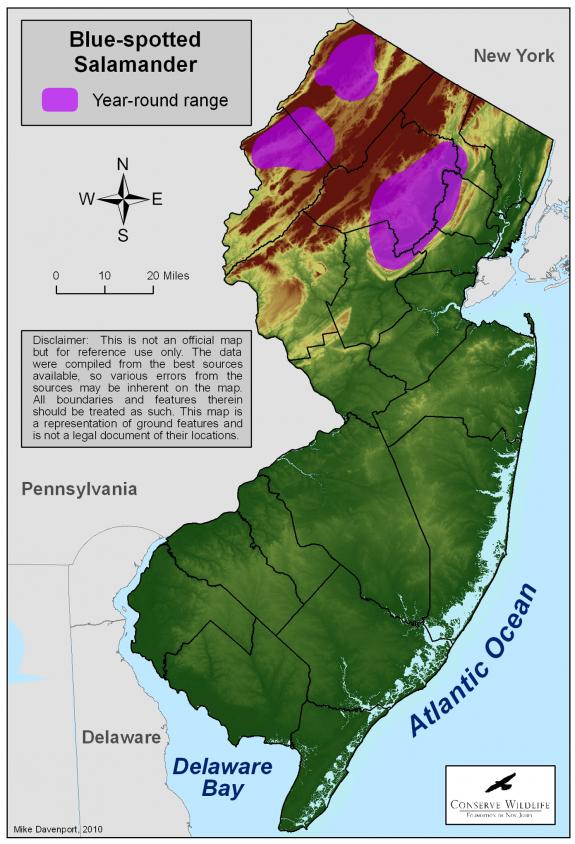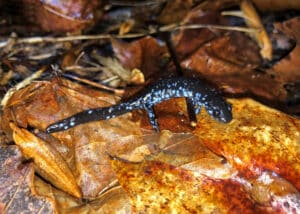Ambystoma laterale
Type: amphibian
Status: endangered
Species Guide
Blue-spotted salamander
Ambystoma laterale
Species Type: amphibian
Conservation Status: endangered
Identification
The blue-spotted salamander is a member of a group of subterranean amphibians known as “mole salamanders.” They are dark blue with light blue flecking on the sides and tail. These salamanders have large heads with protruding eyes and stocky bodies supported by sturdy limbs. The blue-spotted salamander closely resembles the somewhat larger Jefferson Salamander, and hybridization between the species makes identification even more difficult Adults measure 4 to 5.5” in length.

Distribution & Habitat
In New Jersey, the blue-spotted salamander is distributed in Sussex and Warren counties and within the Passaic River basin of Somerset, Essex, Morris, and Passaic counties.
Blue-spotted salamanders live in mature hardwood forests such as red maple swamps and oak/birch woodlands. The terrestrial adult is found in mature woods where there are rotting log, and slightly above water level in swamps and marshlands. Tree species may include oaks, red maple, black willow, and gray birch. Typically, the ground is littered with rotting logs, rocks, or leaves, below which the salamanders dwell within moist depressions or burrows. Temporary woodland ponds and roadside ditches may serve as breeding pools. Temporary breeding ponds have a muddy substrate and contain leaf litter and fallen twigs. Marshy breeding ponds consist of dense underwater vegetation and tussocks of emergent vegetation. The water must be deep enough to prevent the ponds from drying up before the juveniles emerge from the water, yet shallow enough to prevent occupation by predatory fish.
Diet
The diet of adult blue-spotted salamanders includes worms, insects, snails and slugs. Salamander larvae feed on plankton, and aquatic insects. As larvae reach maturity, they are able to capture larger prey items such as tadpoles and other larval salamanders.
Life Cycle
Warming temperatures and increased precipitation in mid to late March trigger the movement of adults to their breeding ponds. Most mating activity occurs during the first few nights of proper weather conditions, but reproduction may continue into early April.

Blue-spotted salamanders exhibit strong fidelity to the natal ponds where they were born. They return to these same ponds to breed when they reach sexual maturity (at two to three years of age). Their loyalty to breeding sites extends into the terrestrial stage. In New Jersey, individuals have been located 1 to 250 meters from their breeding ponds.
Following courtship, males deposit spermatophores at the base of the pond. After collecting and fertilizing them, females lay small clusters of eggs on twigs, leaves, or aquatic vegetation. Each female may lay a total of 300 to 400 eggs. After breeding, the adults retreat to their subterranean homes, leaving the eggs to incubate for 14 to 21 days. The larvae, which measure 12 to 15 mm upon hatching, spend the next 90 to 100 days within the pond. During June or July, the juveniles emerge and disperse to terrestrial locations.
Current Threats, Status, and Conservation
This species exhibits strong fidelity to its breeding ponds and has suffered from degraded water quality in these ponds. Our expanding network of roads has negatively impacted this species by impeding salamander movements into breeding ponds and increasing the incidence of roadside mortality.
The primary threats facing blue-spotted salamanders in New Jersey are the loss, alteration, and degradation of quality habitat. Specialized habitat requirements and strong fidelity to breeding ponds render these salamanders vulnerable to habitat loss. In addition, restricted range and isolated populations hinder their ability to recover from localized extirpations or declines. Within the Passaic River basin, a considerable amount of habitat has been lost to development. An expanding network of roads fragmenting forests may impede salamander movements to breeding ponds or result in road mortality of migrating adults and dispersing juveniles. These salamanders are sensitive to water quality and may therefore be negatively affected by runoff, insecticide spraying, and other pollutants.
Blue-spotted salamander locales, including breeding ponds and terrestrial habitats, should be protected from development, habitat degradation, and the reduction of water quality. In addition, mosquito control efforts, including insecticide spraying, should be restricted in the areas these salamanders occur.
Scientific Classification
- Kingdom: Animalia
- Phylum: Chordata
- Class: Amphibia
- Order: Caudata
- Family: Ambystomatidae
- Genus: Ambystoma
- Species: A. laterale